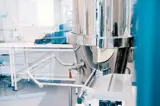Opioid use disorder
Being addictive to drugs is a chronic disease that affects both a person’s brain and their behavior resulting in a significant impact on their quality of life. Treatment of opioid use disorder (OUD) is often administered over long periods of time or chronically.
The most common treatments are Medication Assisted Treatments (MAT) based on buprenorphine, methadone or naltrexone. Buprenorphine is often combined with the antagonist naloxone to help prevent misuse by intravenous injection. The most frequently used medication as part of a MAT program in the US is buprenorphine/naloxone which can be taken under the tongue as a tablet or film. Methadone is most commonly administered orally in a supervised setting, while naltrexone is most frequently given as a monthly injection.
Pharmacological treatment should be provided as part of a complete treatment plan and include behavioral therapy.
People where misuse of opioids has turned to illicit drug use face a large risk of suffering life-threatening overdoses where rescue medications such as naloxone are often required.




